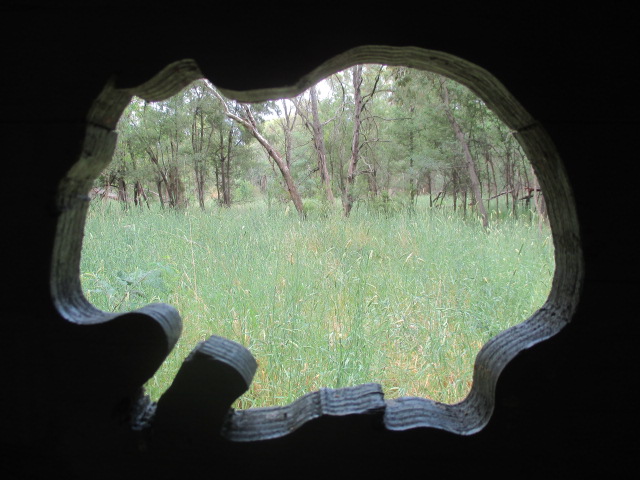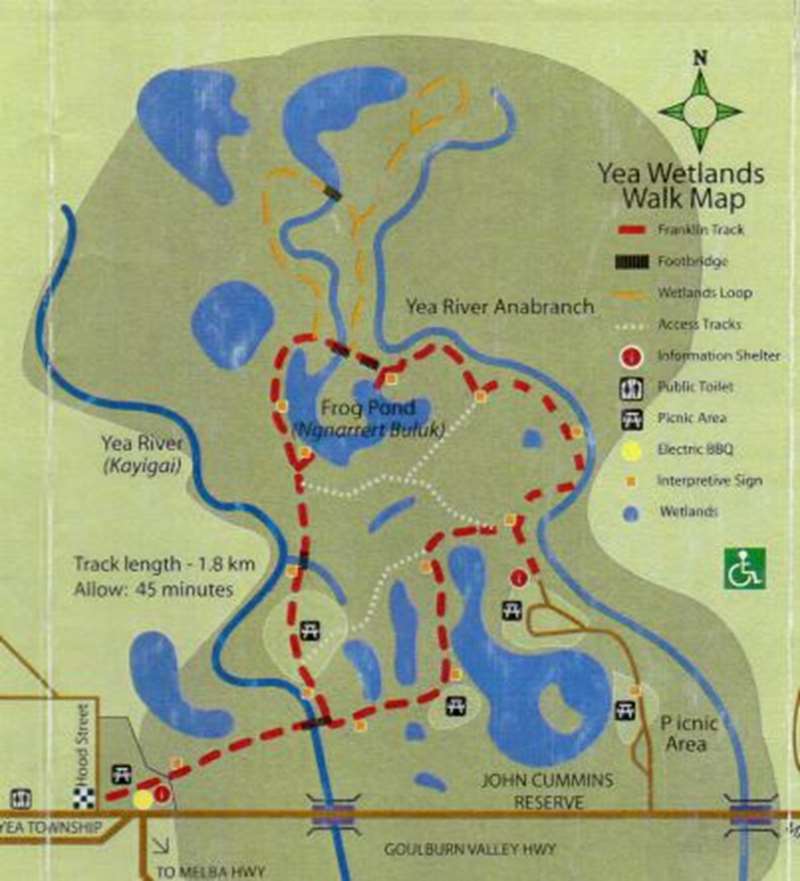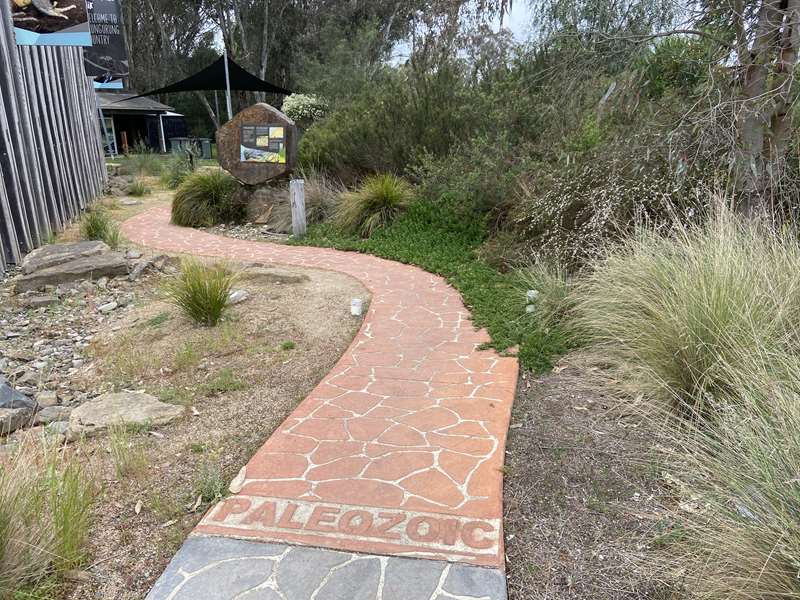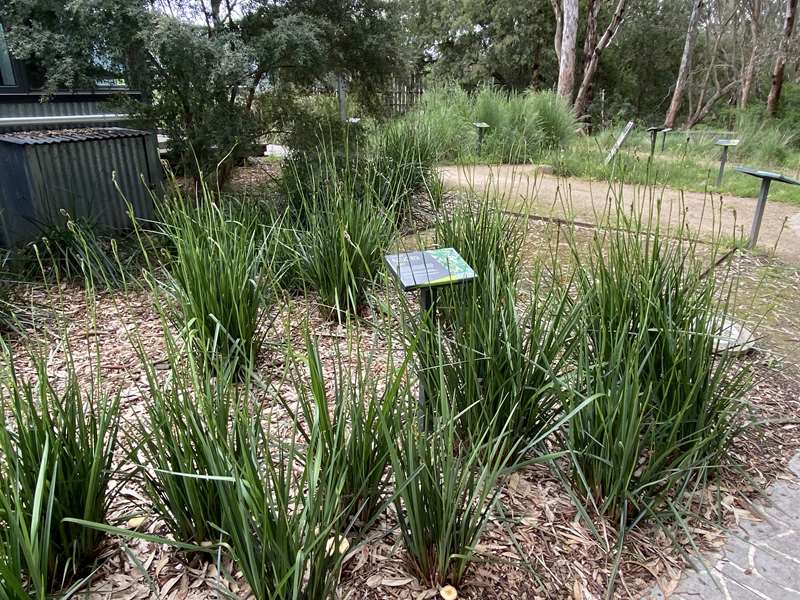Yea Wetlands Walk and Discovery Centre


You will not be disappointed if you take time and enjoy a leisurely stroll along the well defined paths and raised walkways to observe nature doing its thing on the Yea River flood plain, at Yea Wetlands.
Take a leisurely 45 to 60 minute stroll through the Yea Wetlands and you will have the opportunity to see platypus, rakali (native water rats), sacred king fisher, koala, sugar glider or, if you are visiting at the right time, maybe an opportunity to see the rare and ancient damselfly, Hemiphlebia mirabilis, described in scientific journals as a 'living fossil'.
Walk the Franklin Track and discover little known information about the Taungurung Clan, the Aboriginal community that lived in this area prior to European settlement. Learn about their people, their history, food culture and relationship with the environment.
The nearby Y Water Discovery Centre is a multi-purpose facility incorporating an accredited Visitor Information Centre and an Interpretive & Educational Centre. The facility offers a range of services including visitor information (maps, brochures, accommodation and travel guides), a gift shop, free wi-fi, public toilets and meeting room hire.
The interpretive displays draw attention to this region's most valued, yet misunderstood export - water - and all the life dependent on it. Water is Murrindindi Shire's most valuable export.
The Centre aims to inform more people about that precious, yet controversial water resource as well as the birds, and animals that form part of the important ecology of the disappearing wetlands.
Access for Dogs:
Dogs are permitted at Yea Wetlands, but they must be kept on a lead at all times to protect the local wildlife.
Map of Wetlands Area

Over the past years the Yea Wetlands have been transformed from an inaccessible floodplain wetland to become one of Yea's best kept secrets!
Just a short walk from High Street you can now lose yourself in the peace and tranquillity of the natural bush and riverine floodplain wetlands. Just walk down the Franklin Track across the cable suspension bridge, being sure to watch for platypus or native water rats foraging for food along the river bed and you begin to understand the treasure that Yea truly has.
Be sure to look up in the trees occasionally for Koalas and take the ramp off the bridge . You will soon enter a cleared area popular for picnics, functions or just relaxing.... that's one of the secrets - stop, look and listen. You will be surprised at the native birds, plants and animals that you will discover.
Read the interpretive signs and unravel more secrets about the uniquely Australian aquatic mammals. Take care to read the information about how the local Aboriginals, the Taungurung clan, used and treated the wetlands.
Cross the first footbridge and move from ungrazed to recently grazed land. Can-you spot the difference?
Recent plantings using species indigenous to the area have been made but the impacts of past grazing and introduced grass species do confront you. Over time the area will be rehabilitated to provide the habitat necessary to protect for our native species.
The Frog Pond
This billabong is just one of many former courses of the Yea River. It is home to many frog species and a rare, vulnerable damselfly - Herniphlebia Mirabilis - a very tiny and ancient species of metallic coloured damselfly which has only been observed in four other parts of Australia. We call it 'Hemi' for short. Scientists call it a living fossil - it's species is that old!! Notice how the fallen trees are still growing.
As you leave the Frog Pond you will walk up on to a series of boardwalks which allow you to look out over the water and see the numerous birds, frogs and yes, the occasional reptile going about its business. Please be sure not to annoy any snakes and they won't annoy you.
You will pass more interpretive signs and cross another bridge before you meet the Yea Ana-branch - another course of the Yea River. Like the Yea, this has a good population of native fish (black fish, galaxids, Macquarie perch) - as well as introduced species such as redfin, trout and of course, European carp.
Here, you can elect to take the extended Wetland Loop to enjoy other wetlands or continue on the Franklin Track.
The old trees with their deep hollows provide important homes to many kingfishers, sugar gliders, owls, birds and bats. Similarly, fallen trees, once cut for firewood, now remain to house and protect birds, animals and reptiles from predators.
An evening walk, with the aid of a powerful torch, is an experience to be enjoyed by all. Bats, possums, sugar gliders can be observed if you walk quietly and carefully.
As you near Cummins Reserve be sure to visit the 'Flat Plat' a functional 'Art in the Environment' sculpture that is suitable for picnics and a comfortable base for explaining the wetland's many secrets to school students and groups.
Return to the Franklin Track and turn left onto the boardwalk beside Cummins Lagoon - a wetland excavated in 1985 as a joint project by the Yea High School and a local contractor.
Several smaller wetlands can provide surprise sightings of ducks and other water birds that drop in on their migratory journeys.
On return to the suspension bridge climb the steps and retrace your steps back to the Information Shelter and free electric barbeque. You will feel better and be better informed for the experience.
Franklin Track
The Aboriginal people who inhabited the Yea area for tens of thousands of years before Europeans arrived belonged to the Waring Illum Balluk part of the Taungurung clan. They held alliances with several other clans and language groups in Victoria who together are known as the Kulin Nation.
The main walk track in the Yea Wetlands is named after John Franklin a native of the neighbouring Nira Illum Bulluk clan and recognises his contribution to Yea's development and importantly, the District's aboriginal culture heritage.
John Franklin, was somehow separated from his family and their culture at 4 years of age. John later worked in the Yea district as a farm labourer, horse-breaker, drover and farmer, contributing to the development of the area and is honoured by many proud descendants.
Interpretive signs along the route of the Franklin Track include a summary of key stories of how the Aborigines used and valued the natural assets of the Yea regions many waterways and wetlands. They provided a year round source of food and water. More often than not the Aborigines would camp nearby.
The Track and its raised boardwalks follow the highest land within the wetlands .... the path most likely used by the Taungurung as they stalked and hunted through the wetlands for fish, snakes, possums, molluscs and lizards.
The Yea Wetlands were a rich source of 'Bush Tucker' with many native plants used for food, medicine and making clothes and baskets. Several nearby scar trees are evidence that the Aborigines carved the bark using it to make shelter, canoes, shields and baskets.
Take the time to read and enjoy the signs to learn and understand about our Nation's aboriginal heritage.
European Development
On Saturday, 2nd October, 1824 explorers Hamilton Hume and William Hovell began their historic expedition from the County of Cumberland, NSW. Their small party consisted of six men, two carts, three horses and numerous dogs.
Their objective was to explore the land between Cumberland and Westernport. While where they crossed the Yea River is not accurately recorded it is quite likely that they crossed at the shallow riffle that occurs in the river just 100m downstream from the suspension walk bridge.
This area is now a popular spot for the locals and visitors alike to enjoy a paddle in the cool waters, relax in the shade - or celebrate a wedding.
For many years the floodplain swamps adjacent to Yea were used for summer and autumn grazing. This activity, combined with upstream clearing and development for agricultural purposes led to considerable degradation of the natural wetland environment.
The Yea Wetlands Committee has phased out grazing and undertaken extensive works to restore this area as a managed natural wetland.
Yea Fossil Time Path

On the side of the Discovery Centre is the Yea Fossil Time Path. As you walk the path you travel a representation of this land's geological history. As the geological eras pass beneath your feet, plaques to mark each of the periods you travel through are placed to either side of your journey along the snake shaped path. Behind you lies the Ediacaran Period where the first fossils of soft shelled creatures were formed. This era was named after the Old Ediacara minefield in Australia where the oldest multi celled fossils in the
world were found.
The Geological Timescale divides the history of the Earth into four eons that are divided into eras and then periods. You stand here at the beginning of the Palaeozoic Era. Contained within this era you will find the Silurian Period with the earliest recorded vascular land plant , the historic Yea Baragwanathia. Ahead lie the Mesozoic Era, the Age of Reptiles known best for its dinosaurs , and the Cenozoic Era where the first human footsteps were made upon this land. These three eras form the Phanerozoic Eon, the youngest of the four eons that span the geological history of the Earth.
Rocks in the Yea district contain fossils of some of the world's earliest land plants. The most important of these fossils is Baragwanathia longifolia. It belongs to a group of primitive, non-flowering plants called club mosses or lycopods. The fossil plant shows remarkable adaptions that helped it and other plants make the difficult transition from life in the seas to life on land.
Fossils of Baragwanathia longifolia first appear in rocks that were deposited during the Silurian Period, about 420 million years ago.
Yea is included in the Australian National Heritage List because of its outstanding natural heritage values and worldwide significance. This site reveals valuable information about Australia's geological history, the evolution of plants and their successful adaptions to living on land.
The Mesozoic Era is the 'Age of Reptiles', when dinosaurs roamed the earth. Australia has produced a number of exciting dinosaur fossils including a new species of dinosaur, Weewarrasaurus, that was extracted from the opal fields of Lightning Ridge in 2013. Victoria's Fossil fields in the Otway and Strzelecki Ranges have also yielded unique finds. The Leaellynasaura, a small herbivorous dinosaur, was discovered at Dinosaur Cove in 1989 and an Elaphrosaur, a toothless cousin of the Tyrannosaurus rex, was recovered by volunteers at a Cape Otway dig site in 2015. This era is sometimes referred to as the 'Age of Conifers' as these plants rose to become the dominant land flora at this time.
Taungurung Indigenous Garden - Badji Baanang

The garden is a collaborative project between the Goulburn Broken Catchment Management Authority, Murrindindi Shire Council, Taungurung Clans Aboriginal Corporation and Y Water Discovery Centre
Badji Baanang (pronounced ba-dji baa-nang) means 'Oasis' in Taungurung language. The garden has been designed with the access track through the garden to represent the Goulburn River (Waring) This River is the largest River on Taungurung Country and is vitally important as part of Taungurung creation, as the lifeline of Country and as an important cultural resource for Taungurung people.
The plants found in the garden are representative of plants found across Taungurung Country including the high altitude alpine mountains, the foothills of the ranges and the plains into which the rivers and creeks of Taungurung Country flow through.
The garden also incorporates information about indigenous plants and the species that depend on these plants for survival including local birds and butterflies.
Review:
The combination of a walk through the wetlands and a visit to the Discovery Centre is a rewarding experience for visitors.
The wetlands walk is basically a circular route with a few opportunities to add a loop or short diversion. The wetlands are home to several species of snakes and there is a reasonable probability that you'll come across a snake on warm days. The best advice is to keep an eye on the path at all times and if you see a snake, wait until the snake moves off the path. A fair part of the walk is on elevated boardwalks and the remainder is on fairly wide paths which makes the chance of seeing a snake high before you inadvertently get too close.
Initially you cross the Yea River on a 30m cable suspension bridge in order to get to the wetlands area. There are a number of colourful, detailed and informative information boards along the route, a bird hide overlooking a pond, large information boards about the threatened Macquarie Perch (less than 12 populations now remain in the wild) and a hut with animal and bird silhouettes cut out of the walls. The full route took us about 45 minutes.
We saw a range of birds and no snakes (thankfully). As well as the more difficult creatures to spot such as a platypus, rakali (native water rat) and koala, there are birds such as swamphen, heron, cockatoo, ibis, duck and spoonbill in the wetlands.
At the south east corner, accessible by car from the Goulburn Valley Highway is a picnic area with unshaded tables (around Cummins Lagoon) and lovely wooden tables under shade sails.
Around the outside of the Discovery Centre is a table under a shelter with lots of information to read on the walls and a BBQ under shade sails.
The Discovery Centre has a range of interesting interactive exhibits which relate to the theme of water and all the life dependent on it. There are some dark boxes you can put your hand in (if you are brave enough) and try and guess what is inside before a light turns on to reveal whether you are correct. Be warned - there is a redback spider and snake in one box (made of plastic to reduce your blood pressure). Another one of my favourite displays shows where our water goes (68% to agriculture, 16% to industry, 7% from water supply losses, 4.5% to household garden use, 2.25% to flush toilets, 2.2% to other household uses and only less than 0.05% for drinking.
Photos:
Location
2 Hood Street, Yea 3717 View Map
Email Enquiry
Web Links
→ Yea Wetlands Walk (Walk Notes)
→ Yea Wetlands on Facebook
→ Y Water Discovery Centre @ Yea Wetlands









